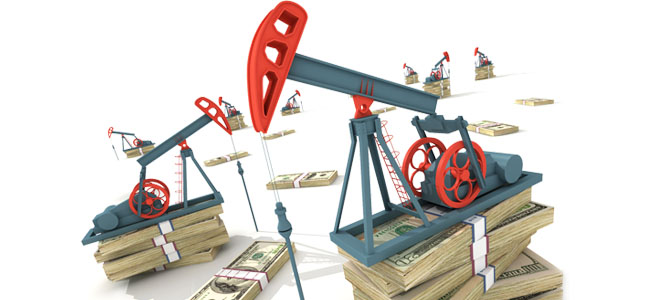The importance of paying attention to investment potential without losing sight of risks is currently epitomized by the oil and gas industry. The need for investors to scrutinize both risks and rewards is always a delicate balancing act — this is reflected in traditional financial tools such as risk-reward ratios and cost-benefit analyses. But the gyrations of energy-related commodities have caught even some industry experts by surprise.
For example, a barrel of oil currently trades for about $40 per barrel — down 50 percent from 2014. The short explanation for this downward trend is provided by a combination of sluggish economies (in Europe, Asia and elsewhere) and increased production from new (and cheaper) extraction methods such as fracking. A longer explanation will include mention of unpredictable factors in a complex industry along with erratic behavior in commodities markets due to speculation and investor psychology.
Declining prices for oil and gas can have both positive and negative consequences. While about 35,000 workers in the American energy industry were laid off in a recent six-month period, the tourism and agriculture industries reaped the positive benefits of declining energy prices. Individual consumers who commute to work on a daily basis are certainly cheering for the continuation of low gas prices.
What will happen next? Some investment banks such as Credit Suisse and Merrill Lynch (now owned by Bank of America) suggest that the industry has its worst days behind it. While there will rarely be an easy solution to the occasional chaos in financial and energy markets, Research Optimus can help investors do a better job of monitoring and understanding what is going on in the oil and gas industry as well as in other industries. It can show you how to assess the investment opportunities in comparison to the potential risks.
What Is the Long-Term Perspective for Oil Producers?
Any investment has a “cycle” of ups and downs. This is why one common-sense investing theory is to “Buy low and sell high.” While there can be short-term cycles that reflect price fluctuations over days and weeks, long-term investors such as Warren Buffett largely ignore short-term fluctuations in favor of the long-term investment potential for both commodities and companies.
Until new technology replaces the underlying need for oil and gas, large oil and gas producers have a viable future. Read our previous blog on challenges of energy industry here: “Oil and Gas: Information and Communications Challenges.” One banking analyst (Bank of America Merrill Lynch) stated, “With global demand estimates moving higher on the margin, we maintain our view that the market is running out of reasons to push oil lower.”
However, even in a moderately bullish scenario for the oil and gas industry, some producers and distributors will fare better than others. There are already some energy companies suffering from a cash shortage due to declining oil prices — hence the industry layoffs noted above. Taking a long-term view of the industry is a prudent approach for all investors. For example, Research Optimus can help investors and investment professionals “crunch the numbers” needed to analyze which companies have current cash-flow risks.
Oil and Gas Investments in a Portfolio
Portfolio management is an ongoing challenge for both experienced and novice investors. Oil and gas investments have provided an “edge” in many portfolios during the past three decades because of diversification opportunities, tax advantages and profit potential.
The strategy of diversifying an investment portfolio usually includes a goal of having investments that will go up while others are going down. Historically speaking, oil and gas stocks are often “counter-cyclical” to many other non-energy stocks. Having a sound group of energy stocks will generally (in a long-term cycle) balance a portfolio and act as a “buffer” against slow economic growth that can drive non-energy stocks downward in market value.
Tax benefits — particularly in the United States — can act as a meaningful “price support” mechanism for oil and gas investments. Even before actual oil and gas production is realized, exploration and production companies receive substantial tax breaks that are typically higher for the energy industry than any other industry. Expenses such as tangible and intangible drilling costs and lease costs can be deducted from operating revenues to minimize taxes owed.
The profit potential of oil and gas drilling can be substantial when oil reserves are found. In addition to producing revenues for many years to come, the RoI (return on investment) is frequently five to ten times the amount of the initial investment. This profit margin is hard to replicate in most other industries.
The External Environment for Oil and Gas — Natural, Political and Economic Risks
Reducing all risks to zero is virtually impossible for any investment — the most prudent goal is to understand, manage and control risks. Some risks such as the following will be largely beyond the oil and gas investor’s control:
- Drilling success is never assured — Failure to discover an oil or gas reserve can result in a 100 percent loss of the drilling company’s investment. Smaller firms will particularly be at more risk due to limited financial reserves that can absorb such losses.
- Political conflicts can impact everything — Political instability in areas such as Iraq or Nigeria is an obvious example. But even in stable areas such as Canada and the United States, governments can change the legal “rules” for oil and gas production.
- Drilling success is not the same as economic success — Even when drilling ventures discover oil or gas reserves, declining global market prices can make the overall result unprofitable in the near term.
- Fraud and scams are not uncommon — Complicated tax and accounting regulations in the oil and gas industry make it more feasible for fraudulent-minded “cheaters” to hide true costs and results. Due diligence is essential at every step.
Is there a solution for understanding and managing these predominantly “uncontrollable” risks? Analyses provided by Research Optimus represent one of best possible ways to perform your investment “due diligence” ahead of time. We have more than a decade of experience in reducing risks through our proprietary research methods. Research Optimus can help investors thoroughly evaluate individual oil and gas companies as well as the global energy markets.
A Few Final Words from Research Optimus
Investing in the oil and gas industry is traditionally subject to “on the one hand and on the other hand” considerations — perhaps even more so in the current atmosphere of declining energy prices. For example, on the one hand, oil and gas industry investors can benefit from the triple benefits of portfolio diversification, tax breaks and high potential profit margins. On the other hand, energy investors must be cognizant of natural, political and economic risks noted in the preceding paragraph.
What should you do? If you agree with the prevailing long-term wisdom that oil will always be needed, prudent investing can produce profitable opportunities even in the face of risks. One sound solution is to find an experienced investment research partner — Research Optimus can help you optimize your long-term investment strategy.
– Research Optimus





